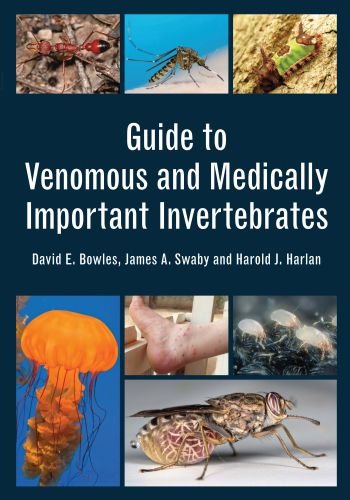Guide to Venomous and Medically Important Invertebrates
By David Bowles, James Swaby, Harold Harlan, Year 2018, File Type: PDF

Guide to Venomous and Medically Important Invertebrates describes the health threats posed by invertebrate groups worldwide, from physical pain and annoyance to disease transmission risk. Featuring clear photographs, distribution maps and descriptions of biological, physical and behavioral characteristics of key groups, this book aids identification of potentially harmful invertebrates. It also summarizes personal protection measures to reduce the risk of attack and disease, and provides guidance on treatment.
This book will help to protect the health of travelers and serve as a reference for medical personnel working in high-risk areas, as well as those interested in entomology.
Doctors David Bowles, James Swaby and Harold Harlan are retired United States military medical entomologists. They have more than 90 years’ collective experience working with and publishing on venomous and medically important invertebrates from around the world.
This guide presents a basic yet sound understanding of potentially dangerous invertebrates that travelers and adventures may encounter. Our intent is not to provide a definitive or exhaustive description of every species, but instead we briefly discuss biological, physical and behavioural characteristics of key groups in an attempt to give the reader a better direction on identity. We have attempted to show in photographs the appearance of the animals we discuss, but we recognise that the range of variation seen in nature may not be entirely reflected in the photos we present. Distributional maps are presented only as general information and are not intended to be specific range boundaries.
This guide considers only animals posing a direct contact threat, not toxic food reactions, contact allergies or poisonous animals that must be consumed. In addition, a few other invertebrates are included because they are often incorrectly presumed dangerous.
We reviewed and consolidated the exhaustive literature available, but, to make it concise, individual information sources are not cited in the text. We do list selected reliable resources and references should the reader be interested in learning more about the animals described. Get Now: Venomous Reptiles and Their Toxins – Evolution, Pathophysiology and Biodiscovery PDF
To make the guide easy to use while ‘on the go’, we streamlined the text and used common language to describe the invertebrates and their associated reaction symptoms. In some situations, we used medical and technical terms for brevity or to avoid confusion. Similarly, many invertebrates are commonly called different names, depending on location. We include those common names, but associate them and all other information with their presently accepted scientific name and associated higher taxonomic nomenclature (phylum, class, order, family, genus). This will assist you to find additional information on those species or groups.
Most medical treatments included in this book involve only basic first-aid procedures, although some responses may involve complex medial intervention. Treatment guidelines, when presented, are based on information available when this guide was written.
Travelers/adventures and medical-care providers should consult the most current, reliable information available to ensure correct treatment regimens. Medical practitioners are solely responsible for medications, dosages and therapies prescribed.
This Book is Available For Premium Members Only (Register Here)
Unlock 3000+ Veterinary eBooks or Go To Free Download
